 |
||||
|
|
||||
|
|
|
|
|
|
|
|
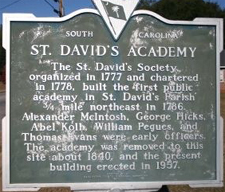 The St. David's Society, organized in 1777 and chartered in 1778, built the first public academy in St. David's Parish ¾ mile northeast in 1786. Alexander McIntosh, George Hicks, Abel Kolb, William Pegues, and Thomas Evans were early officers. The academy was removed to this site about 1840 and the present building was erected in 1957. |
||
| On December 20, 1821, the South Carolina General Assembly passed an Act, which included the incorporation of the Springville Academy of Darlington District (Section XI), and named seven (7) trustees of said academy. | ||
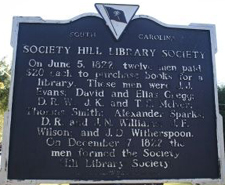 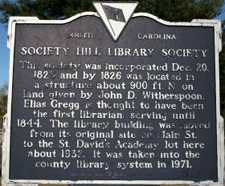 On June 5, 1822, twelve men paid $20 each to purchase books for a library. These men were J. J. Evans; David and Elias Gregg; D. R. W., J. K. and T. E. McIver; Thomas Smith; Alexander Sparks; D. R. and J. N. Williams; J. F. Wilson; and J. D. Witherspoon. On December 7, 1822 the men formed the Society Hill Library Society. This society was incorporated Dec. 20, 1823 and by 1826 was located in a structure about 900 ft. N. on land given by John D. Witherspoon. Elias Gregg is thought to have been the first librarian, serving until 1844. The library building was moved from its original site on Main St. to the St. David's Academy lot here about 1932. It was taken into the county library system in 1971. |
||
| On December 20, 1823, the South Carolina General Assembly passed an Act, which included the incorporation of The Library Society of Society Hill in the Darlington District (Section XVIII). In the same Act, the South Carolina General Assembly also incorporated the Darlington Academy, naming seven (7) members of said academy (Sections XXII and XXIII), who were authorized to raise up to $5,000 via a lottery. | ||
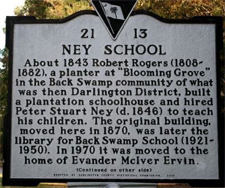 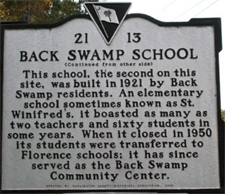 About 1843 Robert Rogers (1808-1882), a planter at "Blooming Grove" in the Back Swamp community of what was then Darlington District, built a plantation schoolhouse and hired Peter Stuart Ney (d. 1846) to teach his children. The original building, moved here in 1870, was later the library for Back Swamp School (1921-1950). In 1970 it was moved to the home of Evander McIver Ervin. This school, the second on the site, was built in 1921 by Back Swamp residents. An elementary school sometimes known as St. Winifred's, it boasted as many as two teachers and sixty students in some years. When it closed in 1950 its students were transferred to Florence schools; it has since served as the Back Swamp Community Center. [Note - The Ney School was originally in the Darlington District. In 1888, it was in Florence County. St. Winifred's was always in Florence County. The marker above is in Florence County] |
||
| On December 20, 1853, the South Carolina General Assembly passed an Act, which included the incorporation of the Society Hill Library Society (Sections I, II & III). It is unclear if this is just a renewal or if the original charter had lapsed and this was a new incorporataion. | ||
| On December 19, 1855, the South Carolina General Assembly passed an Act, which included the incorporation of the Springville Academy in Darlington (Sections I & II). | ||
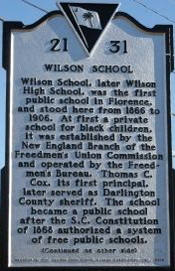 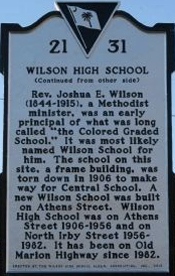 Wilson School, later Wilson High School, was the first public school in Florence, and stood here from 1866 to 1906. At first a private school for black children, it was established by the New England Branch of the Freedmen’s Union Commission and operated by the Freedmen’s Bureau. Thomas C. Cox, its first principal, later served as Darlington County sheriff. The school became a public school after the S.C. Constitution of 1868 authorized a system of free public schools. Rev. Joshua E. Wilson (1844-1915), a Methodist minister, was an early principal of what was long called “the Colored Graded School.” It was most likely named Wilson School for him. The school on this site, a frame building, was torn down in 1906 to make was for Central School. A new Wilson School was built on Athens Street. Wilson High School was on Athens Street 1906-1956 and on North Irby Street 1956-1982. It has been on Old Marion Highway since 1982. [Note - The Wilson School was originally in Darlington County. In 1888, it was in Florence County. The marker above is in Florence County.] |
||
|
On February 14, 1873, the South Carolina General Assembly passed an Act to incorporate the Florence Educational Association, of Florence, South Carolina, named six (6) members, authorized assets up to $20,000, and chartered the group indefinitely, until repealed. [Note - the town of Florence and this organization was in Darlington County until 1888, when Florence County was established.] |
||
| On February 26, 1873, the South Carolina General Assembly passed an Act to incorporate the Darlington Academical Society, named eight (8) members, and authorized assets up to $20,000. The Act also specified that all assets of the earlier Academy established in the town of Darlington Court House were to be transferred to this new society, again for an Academy in said town. | ||
|
On December 24, 1883, the South Carolina General Assembly passed an Act to establish a new special school district in the town of Florence in Darlington County, and authorized voters to decide upon an additional special school tax not to exceed two (2) mills on real and personal property. [Note - the town of Florence will be in Florence County in 1888.] |
||
|
Also on December 24, 1883, the South Carolina General Assembly passed another Act to establish a new special school district in the town of Timmonsville in Darlington County, and authorized voters to decide upon an additional special school tax not to exceed two (2) mills on real and personal property. On December 22, 1886, the South Carolina General Assembly passed another Act to amend the Act of 12/24/1883, and modified the boundaries of the school district in the town of Timmonsville. [Note - the town of Timmonsville will be in Florence County in 1888.] |
||
| On December 24, 1888, the South Carolina General Assembly passed an Act to establish a new special school district in the town of Darlington Court House, in Darlington County, and authorized voters to decide upon an additional special school tax not to exceed three (3) mills on real and personal property. St. John's Academy trustees to be on the Board of Trustees for this new school district. School District also authorized to issue bonds up to $5,000 for the purpose of erecting and furnishing suitable school buildings in said school district, again provided that voters approve. On December 23, 1889, the South Carolina General Assembly passed an Act to amend the Act of 12/24/1888, by redefining the boundaries of the school district, and increasing the special school tax to five (5) mills on real and personal property. On February 28, 1896, the South Carolina General Assembly passed an Act to amend the Act of 12/24/1888, by redefining the boundaries of the town of Darlington School District. | ||
| On December 24, 1890, the South Carolina General Assembly passed an Act to authorize the sale of a certain building in the City of Columbia, with the lot on which it stands, known as Agricultural Hall; that four-acre lot in said city known as the Fish Pond tract or lot; that tract of land known as the Experimental Farm at Columbia, with the personal property belonging thereto; that certain farm and tract of land, containing two hundred and twenty-seven 21-100 acres, in the County of Darlington, known as the South Carolina Agricultural Farm and Station in Darlington County, together with the personal property thereon and appertaining thereto; and that certain tract of land in Spartanburg County, near the City of Spartanburg, containing 14 4-100 acres, more or less, with the buildings and with the personal property thereunto belonging, known as that part of the South Carolina Agricultural Farm and Station situated in Spartanburg County. That the proceeds of such sale or sales, whether in money or securities, shall be turned over to the State Treasurer, to be by him held subject to the draft or order, as the case may be, of the Trustees of the Clemson Agricultural College, for the use of the said Clemson Agricultural College, to which college the said proceeds are hereby appropriated, except for the Darlington County Farm and Station and property - the funds shall be distributed to Darlington County and Florence County for general county use. | ||
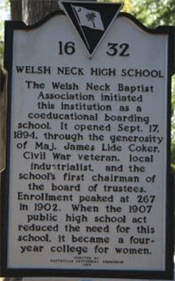 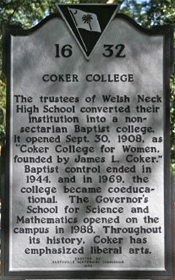 The Welsh Neck Baptist Association initiated this institution as a coeducational boarding school. It opened Sept. 17, 1894, through the generosity of Maj. James Lide Coker, Civil War veteran, local industrialist, and the school's first chairman of the board of trustees. Enrollment peaked at 267 in 1902. When the 1907 public high school act reduced the need for this school, it became a four-year college for women. The trustees of Welsh Neck High School converted their institution into a non-sectarian Baptist college. It opened Sept. 30, 1908, as "Coker College for Women, founded by James L. Coker." Baptist control ended in 1944, and in 1969, the college became coeducational. The Governor's school for Science and Mathematics opened on the campus in 1988. Throughout its history, Coker has emphasized liberal arts. |
||
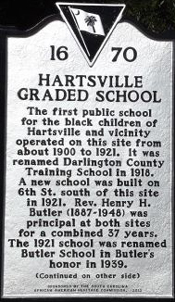 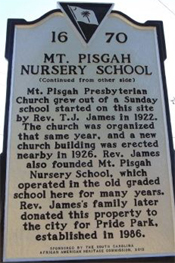 The first public school for the black children of Hartsville and vicinity operated on this site from about 1900 to 1921. It was renamed Darlington County Training School in 1918. A new school was built on 6th St. south of this site in 1921. Rev. Henry H. Butler (1887 ~ 1948) was principal at both sites for a combined 37 years. The 1921 school was renamed Butler School in Butler’s honor in 1939. Mt. Pisgah Presbyterian Church grew out of a Sunday school started on this site by Rev. T.J. James in 1922. The church was organized that same year, and a new church building was erected nearby in 1926. Rev. James also founded Mt. Pisgah Nursery School, which operated in the old graded school here for many years. Rev. James’s family later donated this property to the city for Pride Park, established in 1986. |
||
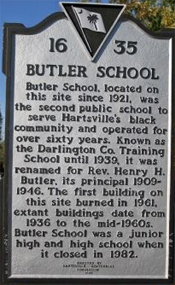 Butler School, located on this site since 1921, was the second public school to serve Hartsville's black community and operated for over sixty years. Known as the Darlington Co. Training School until 1939, it was renamed for Rev. Henry H. Butler, its principal 1909-1946. The first building on this site burned in 1961; extant buildings date from 1936 to the mid-1960s. Butler School was a junior high and high school when it closed in 1982. |
||
 |
 |
© 2016 - J.D. Lewis - PO Box 1188 - Little River, SC 29566 - All Rights Reserved